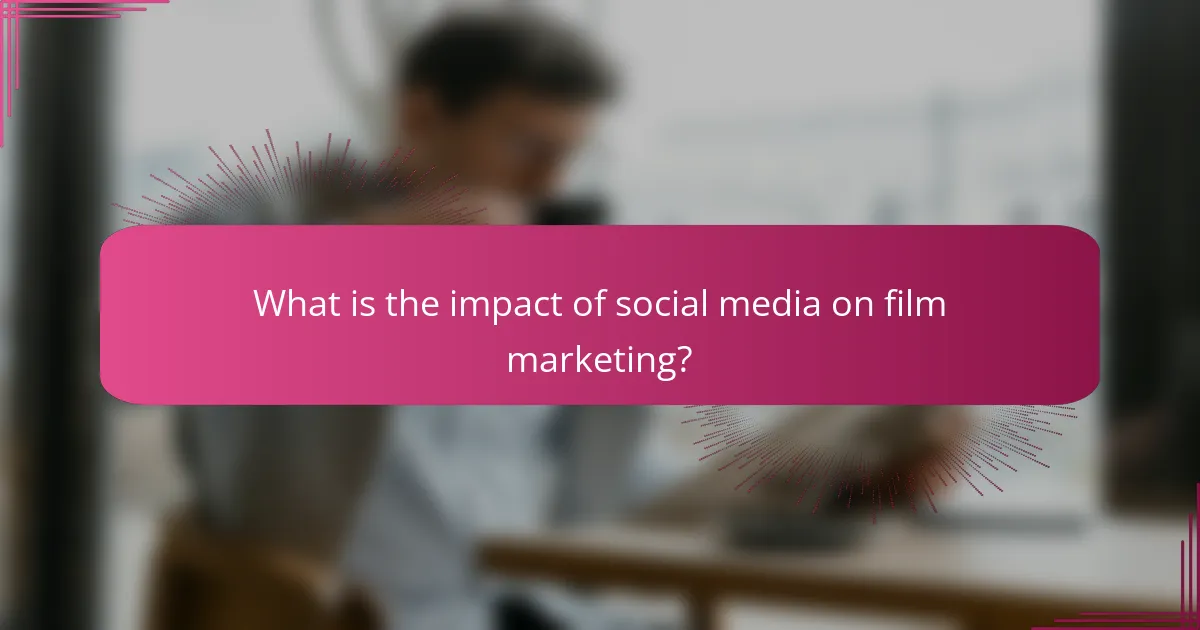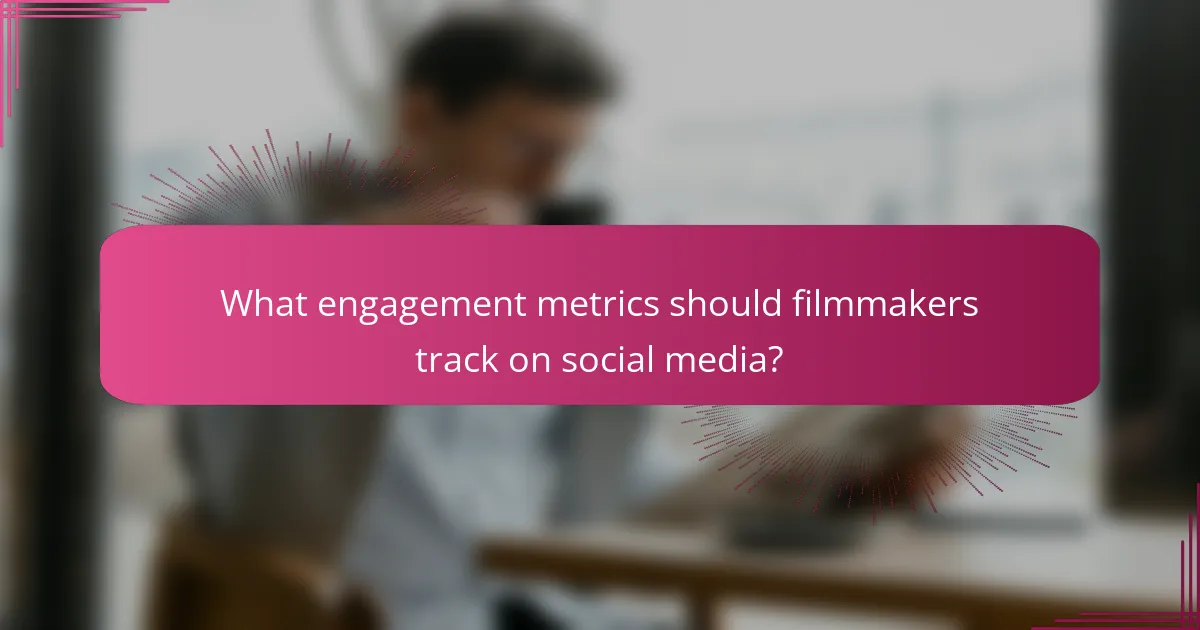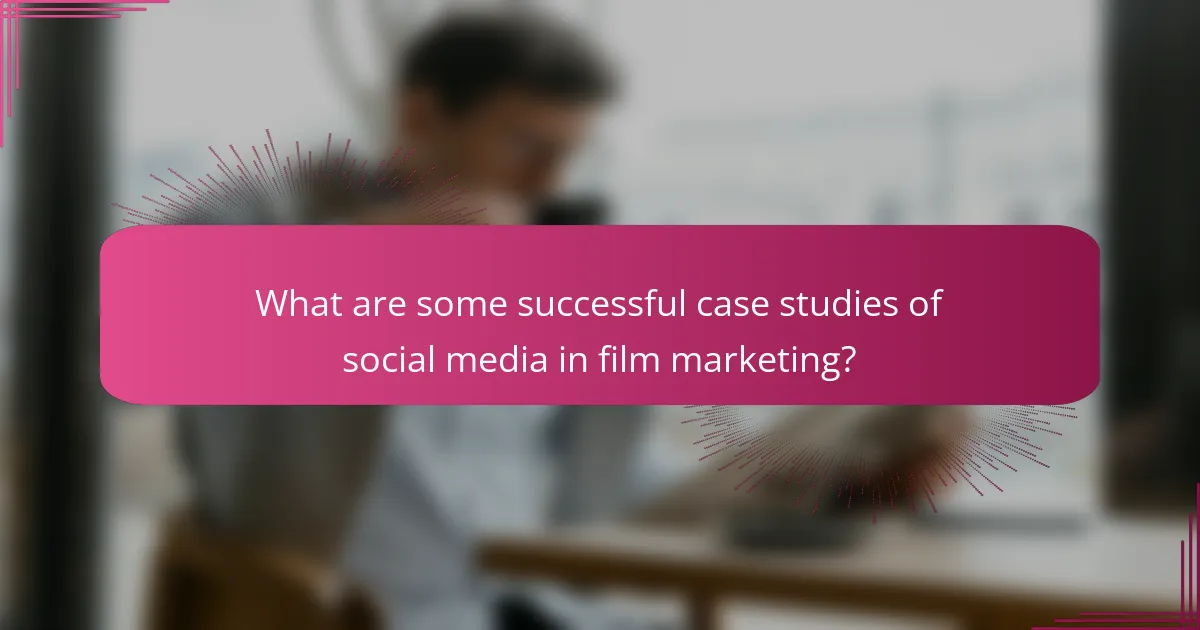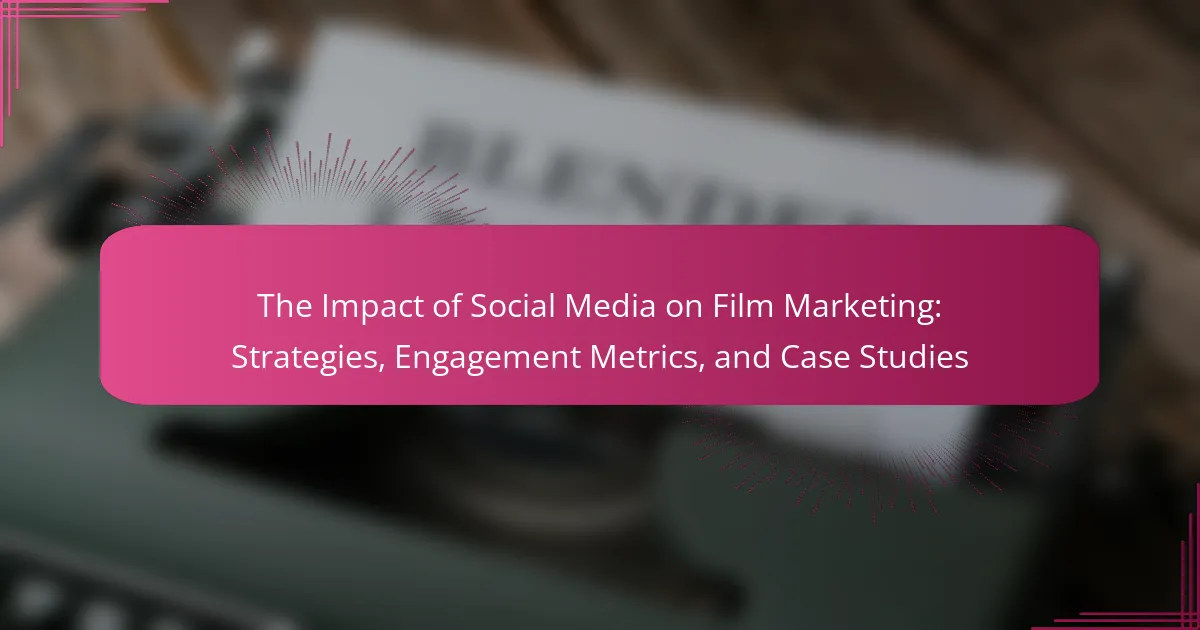Social media plays a crucial role in film marketing by enhancing audience engagement and expanding reach. Platforms such as Facebook, Twitter, and Instagram facilitate direct connections between filmmakers and fans, generating anticipation for new releases. Key engagement metrics, including likes, shares, comments, and overall reach, are essential for assessing the effectiveness of marketing campaigns. Successful case studies like “Deadpool,” “The Blair Witch Project,” and “Get Out” illustrate how innovative social media strategies can lead to significant box office success, highlighting the importance of audience interaction and content engagement in modern film marketing.

What is the impact of social media on film marketing?
Social media significantly enhances film marketing by increasing audience engagement and reach. It allows filmmakers to connect directly with fans. Platforms like Facebook, Twitter, and Instagram facilitate real-time interaction. This interaction builds anticipation and buzz around upcoming releases. According to a 2020 report by Statista, 79% of moviegoers discover films through social media. Additionally, viral marketing campaigns can lead to exponential audience growth. Social media also provides valuable metrics for assessing campaign effectiveness. These metrics help marketers refine their strategies for future projects.
How has social media changed traditional film marketing strategies?
Social media has significantly transformed traditional film marketing strategies. It has shifted focus from mass advertising to targeted engagement. Marketers now utilize platforms like Facebook, Instagram, and Twitter to reach specific audiences. This allows for personalized content that resonates with viewers. Additionally, social media facilitates real-time interaction between filmmakers and fans. This direct communication fosters community and builds anticipation for releases. Statistics show that films with active social media campaigns see increased box office performance. For instance, the film “Deadpool” leveraged social media for its marketing, leading to a $782 million global box office. Overall, social media has made film marketing more dynamic and interactive.
What are the key differences between social media marketing and traditional marketing?
Social media marketing focuses on online platforms to engage audiences, while traditional marketing uses offline channels like print and TV. Social media allows for real-time interaction and feedback, enhancing customer engagement. Traditional marketing often relies on one-way communication, limiting audience interaction. Additionally, social media marketing is typically more cost-effective, reaching wider audiences at lower costs. In contrast, traditional marketing can be more expensive due to production and distribution costs. Analytics in social media provide immediate insights into campaign performance, unlike traditional marketing, which may take longer to measure effectiveness.
How do social media platforms influence audience reach for films?
Social media platforms significantly enhance audience reach for films. They facilitate targeted marketing and engagement with specific demographics. Platforms like Facebook, Instagram, and Twitter allow filmmakers to share trailers, behind-the-scenes content, and promotional material. This direct interaction fosters community and anticipation among potential viewers. Statistics show that films with strong social media campaigns often see increased box office performance. For instance, a study by the USC Annenberg Inclusion Initiative found that films with active social media presence had higher audience engagement. Moreover, social media enables viral marketing, where user-generated content can amplify reach exponentially. Overall, these platforms are crucial in shaping audience awareness and interest in films.
What strategies can filmmakers use to leverage social media?
Filmmakers can leverage social media through targeted content creation, audience engagement, and strategic partnerships. Targeted content creation involves sharing behind-the-scenes footage, trailers, and interviews to generate interest. Consistent posting schedules help maintain audience engagement and keep the film top-of-mind. Filmmakers should interact with fans through comments and live Q&A sessions, fostering a community around the film. Strategic partnerships with influencers can expand reach and attract new viewers. According to a 2021 study by the University of Southern California, films with active social media campaigns saw a 30% increase in box office revenue compared to those without.
What types of content are most effective for engaging audiences on social media?
Visual content is most effective for engaging audiences on social media. This includes images, videos, and infographics. Studies show that posts with visuals receive 94% more views than those without. Videos, in particular, generate 1200% more shares than text and images combined. Interactive content, such as polls and quizzes, also boosts engagement significantly. According to research by HubSpot, 80% of consumers prefer interactive content over static content. User-generated content fosters community and increases trust, leading to higher engagement rates. Lastly, storytelling through posts creates emotional connections, enhancing audience engagement.
How can filmmakers utilize influencer partnerships in their marketing campaigns?
Filmmakers can utilize influencer partnerships to enhance their marketing campaigns effectively. Influencers can reach targeted audiences that align with the film’s demographic. Collaborating with influencers increases visibility and engagement through authentic content. For instance, influencers can create behind-the-scenes videos or host watch parties. This strategy fosters community interaction and excitement around the film. According to a study by the Digital Marketing Institute, influencer marketing can yield an ROI of $6.50 for every dollar spent. By leveraging influencers, filmmakers can tap into established trust and credibility with potential viewers.

What engagement metrics should filmmakers track on social media?
Filmmakers should track several key engagement metrics on social media. These metrics include likes, shares, comments, and overall reach. Likes indicate the level of audience approval and interest in content. Shares demonstrate how much viewers want to spread the word about the film. Comments provide direct feedback and insight into audience perceptions. Overall reach measures how many unique users have seen the content. Additionally, tracking video views and watch time can reveal audience retention and engagement levels. According to a 2021 study by Hootsuite, posts with higher engagement rates lead to increased visibility and organic reach. This data underscores the importance of monitoring these metrics for effective film marketing strategies.
How do engagement metrics impact the success of film marketing campaigns?
Engagement metrics significantly influence the success of film marketing campaigns. High engagement rates indicate that audiences are actively interacting with the content. This interaction can lead to increased brand awareness and audience reach. Metrics such as likes, shares, comments, and views provide insights into audience preferences. For instance, a study by the American Marketing Association found that campaigns with high engagement saw a 20% increase in ticket sales. Effective tracking of these metrics allows marketers to adjust strategies in real-time. This adaptability can enhance overall campaign effectiveness. Ultimately, engagement metrics serve as a critical indicator of campaign health and potential success.
What are the most important metrics to monitor for social media campaigns?
The most important metrics to monitor for social media campaigns include engagement rate, reach, impressions, and conversion rate. Engagement rate measures interactions such as likes, shares, and comments relative to total followers. Reach indicates the total number of unique users who see the content. Impressions reflect the total number of times content is displayed, regardless of clicks. Conversion rate tracks the percentage of users who take a desired action, such as signing up or making a purchase. Monitoring these metrics helps assess campaign effectiveness and optimize strategies for better performance.
How can filmmakers analyze audience feedback through social media metrics?
Filmmakers can analyze audience feedback through social media metrics by monitoring engagement data. They should track likes, shares, comments, and mentions related to their films. These metrics reveal audience sentiments and preferences. For instance, high engagement rates often indicate positive reception. Filmmakers can also utilize sentiment analysis tools to gauge emotional responses. Tools like Brandwatch and Hootsuite provide insights into audience reactions. Analyzing demographic data from social media platforms helps filmmakers understand their target audience better. This data can inform marketing strategies and future projects.
What role does audience interaction play in film marketing effectiveness?
Audience interaction significantly enhances film marketing effectiveness. Engaging with audiences fosters a sense of community and investment in the film. It encourages word-of-mouth promotion, which is a powerful marketing tool. According to a study by the University of Southern California, films that actively engage audiences on social media tend to have higher box office returns. Interaction allows filmmakers to receive immediate feedback, helping them tailor marketing strategies. Additionally, audience-generated content can amplify reach and authenticity. This interaction builds anticipation and excitement around the film’s release. Overall, audience interaction is crucial for maximizing marketing impact in the film industry.
How can filmmakers encourage audience participation on social media?
Filmmakers can encourage audience participation on social media by creating interactive content. This includes polls, quizzes, and challenges related to their films. Engaging storytelling in posts invites comments and shares. Filmmakers should also respond to audience interactions promptly. This fosters a sense of community and belonging. Utilizing hashtags increases visibility and encourages user-generated content. Collaborating with influencers expands reach and attracts diverse audiences. According to a study by the Pew Research Center, 69% of adults use social media, making it essential for filmmakers to leverage these platforms.
What are the benefits of creating interactive content for film marketing?
Creating interactive content for film marketing enhances audience engagement and drives deeper connections. Interactive elements, such as quizzes and polls, encourage participation, making viewers feel involved. According to a study by HubSpot, interactive content generates two times more conversions than passive content. This increased engagement leads to higher brand recall and positive sentiment towards the film. Additionally, interactive content can provide valuable data on audience preferences. This data helps marketers tailor future campaigns more effectively. Ultimately, interactive content fosters community and conversation around films, amplifying word-of-mouth marketing.

What are some successful case studies of social media in film marketing?
“Deadpool” utilized social media effectively, generating significant buzz before its release. The film’s marketing team engaged fans through humorous content on platforms like Twitter and Facebook. They created memes and viral videos that resonated with the audience. This approach resulted in a $132 million opening weekend, exceeding expectations.
Another case study is “The Blair Witch Project.” Its marketing relied heavily on social media and online forums. The filmmakers created a website that presented the film as a real documentary. This strategy built intrigue and suspense, leading to a $248 million box office success on a $60,000 budget.
“Get Out” also exemplified successful social media marketing. The film’s team used Twitter to engage with audiences and encourage discussions about its themes. The hashtag #GetOutChallenge went viral, further enhancing its visibility. The film grossed over $255 million worldwide against a $4.5 million budget.
These case studies demonstrate the effectiveness of social media in film marketing. They highlight how engaging content and audience interaction can lead to substantial box office success.
Which films have effectively used social media for marketing, and what strategies did they employ?
“Deadpool” effectively used social media for marketing. It employed humor and self-awareness in its campaigns. The film’s team engaged fans through memes and interactive content. They utilized platforms like Twitter and Instagram for targeted promotions. “The Blair Witch Project” used social media to create a viral marketing campaign. It generated buzz through a website that blurred fiction and reality. “It Follows” leveraged social media by sharing user-generated content. This strategy fostered community engagement and excitement. “Cloverfield” created mystery with a teaser campaign on social media. It encouraged speculation and discussions among fans. Each film’s strategy focused on direct engagement and community building.
What lessons can be learned from successful film marketing campaigns on social media?
Successful film marketing campaigns on social media demonstrate the importance of audience engagement. Engaging content, such as behind-the-scenes footage, generates interest and excitement. Campaigns that utilize targeted ads reach specific demographics effectively. Collaborating with influencers expands the campaign’s reach and credibility. User-generated content fosters a sense of community and involvement. Timing the release of content around key dates maximizes visibility. Analyzing engagement metrics informs future strategies and optimizes performance. These lessons highlight the need for creativity and adaptability in social media marketing.
How did social media contribute to the overall success of these films?
Social media significantly contributed to the overall success of these films by enhancing audience engagement and increasing visibility. Platforms like Twitter and Instagram allowed for real-time interaction between filmmakers and fans. This interaction created buzz and anticipation prior to the film’s release. Additionally, social media facilitated targeted marketing strategies, reaching specific demographics effectively. For example, promotional campaigns on Facebook can generate millions of views and shares. Data shows that films with active social media campaigns tend to have higher box office revenues. Social media also enables viral marketing, where user-generated content spreads rapidly, further promoting the film. Overall, these factors demonstrate the crucial role social media plays in film marketing success.
What challenges do filmmakers face when using social media for marketing?
Filmmakers face several challenges when using social media for marketing. One major challenge is the oversaturation of content. With millions of posts daily, filmmakers struggle to stand out. Additionally, algorithm changes on platforms can limit organic reach. This often requires filmmakers to invest in paid promotions. Another challenge is the need for constant engagement. Audiences expect regular updates and interaction, which can be resource-intensive. Furthermore, filmmakers must navigate varying platform demographics. Different platforms attract different audiences, complicating targeted marketing efforts. Lastly, filmmakers often deal with negative feedback or criticism online. Managing public perception while promoting a film can be difficult. These challenges highlight the complexities of leveraging social media effectively for film marketing.
How can filmmakers overcome common pitfalls in social media marketing?
Filmmakers can overcome common pitfalls in social media marketing by developing a clear strategy. A well-defined strategy helps filmmakers focus their efforts on targeted audiences. Consistent branding across platforms builds recognition and trust. Engaging content, such as behind-the-scenes footage, captures audience interest. Timely responses to comments and messages foster community engagement. Analyzing metrics allows filmmakers to refine their approach based on audience behavior. Collaborations with influencers can expand reach and credibility. Regularly updating content keeps the audience informed and engaged. These strategies are supported by case studies showing successful social media campaigns in the film industry.
What strategies can mitigate negative feedback on social media platforms?
Addressing negative feedback on social media requires proactive strategies. First, prompt responses to negative comments can mitigate escalation. Engaging directly with users shows that the brand values their feedback. Second, implementing a feedback management system helps track and analyze sentiments. This allows brands to identify recurring issues and address them effectively. Third, maintaining a positive online presence through consistent, quality content can overshadow negative comments. Brands should also encourage satisfied customers to share their experiences. This creates a balance in feedback. Lastly, offering solutions or compensations can turn a negative experience into a positive one. Studies show that brands that engage constructively with criticism can improve their reputation and customer loyalty.
What are the best practices for effective film marketing on social media?
The best practices for effective film marketing on social media include creating engaging content, utilizing targeted advertising, and fostering community interaction. Engaging content should consist of trailers, behind-the-scenes footage, and interactive posts. Targeted advertising allows marketers to reach specific demographics likely to be interested in the film. Fostering community interaction involves responding to comments and encouraging user-generated content. According to a study by the American Film Institute, films that actively engage audiences on social media see a 30% increase in ticket sales. This data reinforces the importance of these practices in driving film marketing success.
How can filmmakers create a cohesive social media strategy for their films?
Filmmakers can create a cohesive social media strategy by defining clear goals. These goals should align with the film’s target audience and marketing objectives. Next, filmmakers should select appropriate platforms based on audience demographics. For instance, Instagram is effective for visual content, while Twitter is suitable for real-time engagement.
Consistent branding across all platforms is essential. This includes using the same logos, color schemes, and messaging. Filmmakers should develop a content calendar to organize posts and ensure regular updates. Engaging content, such as behind-the-scenes footage or interviews, can increase audience interest.
Analytics tools can track engagement metrics and audience feedback. This data helps filmmakers adjust their strategies as needed. Collaborating with influencers can also expand reach and attract new viewers. According to a 2021 study by the American Film Institute, films with active social media campaigns saw a 30% increase in audience engagement.
What tips can filmmakers follow to enhance their social media presence?
Filmmakers can enhance their social media presence by creating engaging content. Regularly posting behind-the-scenes footage can attract followers. Utilizing storytelling techniques in posts builds emotional connections. Collaborating with influencers boosts visibility across platforms. Engaging with followers through comments and messages fosters community. Analyzing engagement metrics helps refine strategies. Using targeted ads can reach specific demographics effectively. Consistent branding across all platforms strengthens recognition.
The primary entity of this article is social media’s impact on film marketing. The article examines how social media enhances audience engagement and reach, transforming traditional marketing strategies by facilitating real-time interaction between filmmakers and fans. It discusses effective strategies filmmakers can use, such as targeted content creation and influencer partnerships, while also highlighting key engagement metrics that should be tracked. Additionally, the article presents successful case studies, illustrating how films like “Deadpool” and “The Blair Witch Project” leveraged social media for substantial box office success, and addresses challenges filmmakers face in this dynamic landscape.
